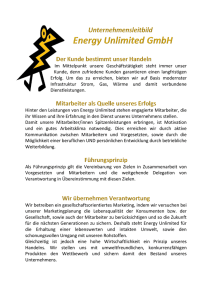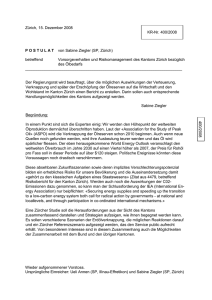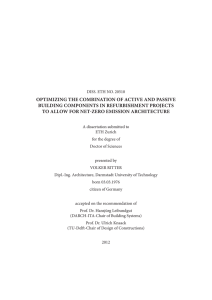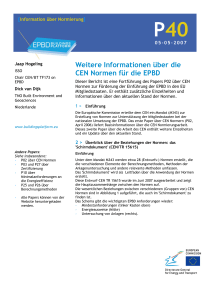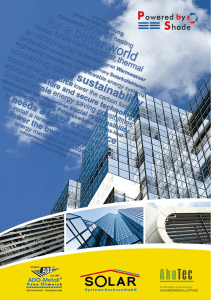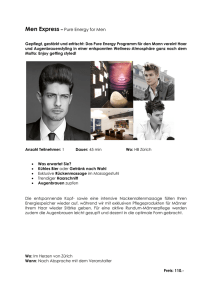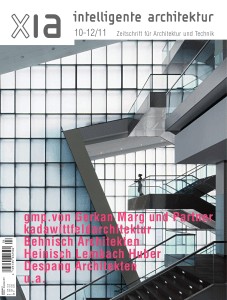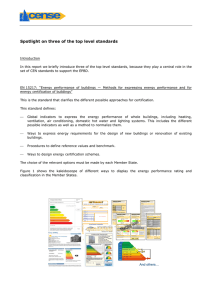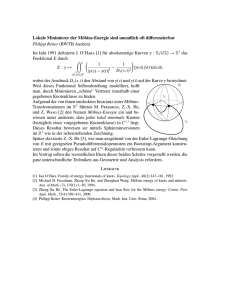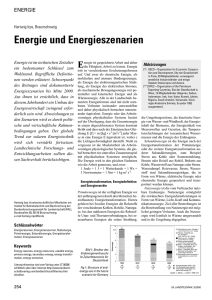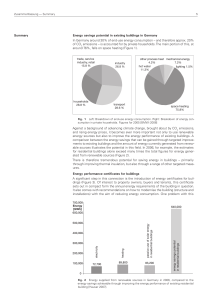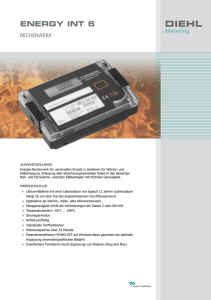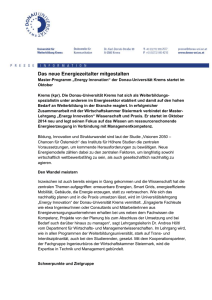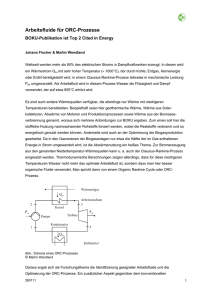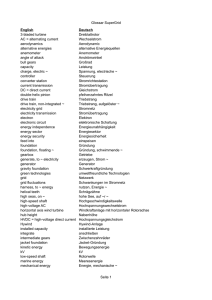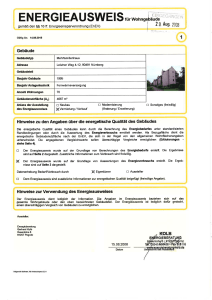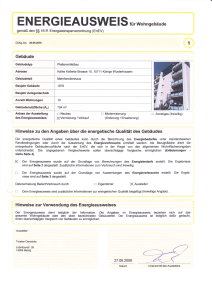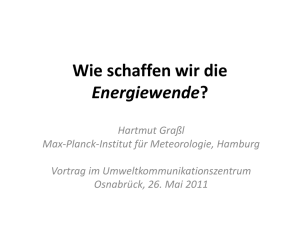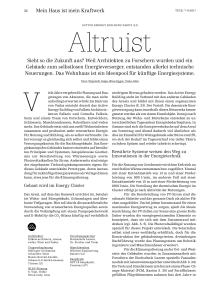EPBD - Federcasa
Werbung
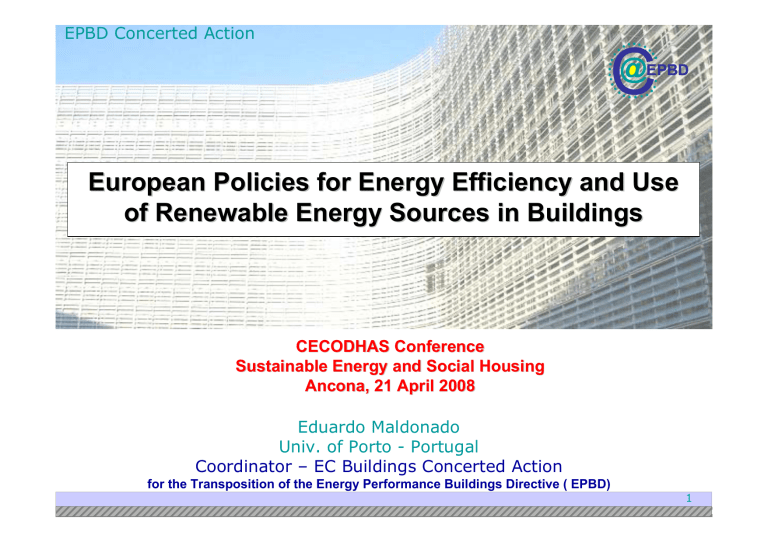
EPBD Concerted Action C @EPBD European Policies for Energy Efficiency and Use of Renewable Energy Sources in Buildings CECODHAS Conference Sustainable Energy and Social Housing Ancona, 21 April 2008 Eduardo Maldonado Univ. of Porto - Portugal Coordinator – EC Buildings Concerted Action for the Transposition of the Energy Performance Buildings Directive ( EPBD) 1 EPBD Concerted Action The main EU Policy Instrument for Building Energy Efficiency C @EPBD Energy Performance of Buildings Directive Directive 2002/91/EC 16 December 2002 published 4 de January 2003 To having been transposed by 4 January 2006 And to be fully implemented by 4 January 2009… 2 EPBD Concerted Action Improving the energy performance in buildings: why ? C @EPBD The EU needs to promote energy savings Three main reasons. Security of supply Environment External energy dependence 70% in 2030 if no measures taken Energy production and use create 94% of CO2 emissions Limited influence on supply The EU can promote savings in energy use Impact of action on energy use in buildings Largest end-user : 40% of energy is used in the residential/ tertiary sectors Large energy savings potential in the building sector: 22% by 2010 3 EPBD Concerted Action IEA Studies point in the same direction C @EPBD 65% 4 EPBD Concerted Action INTEGRATING ENERGY & ENVIRONMENT Energy Policy for Europe (Strategic Energy Review) C @EPBD Limiting Global Climate Change to 2°C STRATEGIC OBJECTIVE A unilateral EU independent commitment of at least 20% GHG emission reduction by 2020, compared to 1990 levels And a 30% reduction if broader participation 5 EPBD Concerted Action ENERGY EFFICIENCY Saving 20% energy by 2020 C @EPBD Energy Efficiency Action Plan - adopted on 19 October 2006 Realising the Potential: Transport - fuel efficient cars; better use of public transport; introduction of biofuels Appliances - tougher standards and better labelling Buildings - improving the energy performance of the EU’s building stock Improving the efficiency of heat and electricity generation, transmission and distribution 6 EPBD Concerted Action C @EPBD THE KEY DRIVERS 3x20% by 2020 20% by 2020 EFFICIENCY By 2020 20% EU GHG By 2020 BIO-FUELS 20% RENEWABLES E-ELECTRICITY HEATING & COOLING 10 % 2020 binding NATIONAL TARGETS and ACTION PLANS 7 EPBD Concerted Action National Energy Plans Energy End-Use Efficiency and Energy Services Directive Directive 2006/32/EC To be transposed in 2007 It requires 1%/year energy consumption savings until 2015 – a very difficult target to reach without a serious effort on buildings, new and existing… But, like the EPBD implementation, the National Energy Plans are delayed in most EU Member States… 8 EPBD Concerted Action EPBD OBJECTIVES C @EPBD Objectives Promoting the improvement of energy performance of buildings within the EU through cost-effective measures, with no compromise to comfort and Indoor air quality. Convergence of building standards towards those of Member States which already have ambitious levels. The measures Apply a Methodology for integrated building energy performance standards based on common minimum requirements Application of these standards on new and existing buildings Certification schemes for all buildings Inspection & assessment of boilers/heating and cooling installations 9 EPBD Concerted Action The measures Latest count of transpositions (out of 25): Apply a Methodology for integrated building energy performance standards based on common minimum requirements 21 Application of these standards on new and existing buildings 13 Certification schemes for all buildings 12 Inspection & assessment of boilers/heating and cooling installations 12 / 7 10 EPBD Concerted Action It is obvious that there are major delays in the implementation of the EPBD in almost every MS, especially for certain topics By: 2007 2008 2009 Undecide d 5 8 6 3 5 19% 48% 70% 81% 5 3 4 8 19% 30% 44% 74% 2006 Timing for starting: New Issue Certificates for Residential Buildings Art.8 - AC- Start Exist. 7 <= 2005 2006 2007 Timing for starting: 2008 Inspections of AC systems 2009 Not Yet Known Not Mentioned 0 2 4 6 8 10 12 Existing buildings and inspections of boilers and AC systems are clear problems. 11 EPBD Concerted Action Why so many long delays? C @EPBD The EPBD approved, and rightly so, as a prime example of the subsidiarity principle (buildings and markets are widely different throughout Europe). The EPBD states the goals that must be reached, but it lets MS a wide range of freedom to implement them. The measures that must be implemented involve added costs for the population (certificates, inspections, …) and there is always a lot of discussion by legislators about measures that impose new responsibilities upon citizens, seen as burdens and “vote loosers”. National Energy Efficiency Plans shall offer incentives and financial assistance mechanisms - the EPBD and the ESD must be implemented in a self-coordinated way The technical options are also quite wide, and there is often a lack of consensus within the technical community about the best option to adopt in each case – decisions are delayed… Some of the measures (e.g., inspection of boilers and AC equipment), in certain cases (e.g., small units in countries with low needs), have questionable cost-effectiveness. 12 EPBD Concerted Action Minimum standards for all buildings New buildings Application of the minimum energy performance standards to all new buildings. Requirements should become more demanding than pre-EPBD national standards, and revised, at least, every 5 years. Consider the feasibility of renewable energy, CHP, etc., for all new buildings over 1000 m². Existing buildings Application of the minimum energy performance standards to existing buildings larger than 1000 m² when they undergo a major renovation. Most MS are adopting new, improved, more demanding building regulations. Integration of Cooling requirements and difficult issues still lagging. 13 EPBD Concerted Action C @EPBD Art.4 – Minimum Requirements • Minimum U-values (indicative, often combined with global consumption targets) Helsinki Helsinki WALLS Helsinki ROOFS Dublin Dublin Budapest Berlin Bratislava Warsaw Ljubliana Bratislava Warsaw Belgium-FL Copenhagen Belgium-BR Sofia Belgium-WR Berlin Copenhagen Warsaw Rome Rome Bratislava Madrid The Hague Ljubliana Athens Sofia The Hague Budapest London Ljubliana Belgium-FL London Belgium-BR Athens Floor to GROUND Dublin Copenhagen Rome Belgium-FL Berlin The Hague London Madrid Sofia Budapest Belgium-WR Lisbon Madrid La Valleta Athens Lisbon Lisbon 0 0.2 0.4 U-Value, W/m2.K 0.6 0.8 La Valleta La Valleta U-Value, W/m2.K U-Value, W/m2.K 0 0.2 0.4 0.6 0.8 1 0 0.2 0.4 County improvements ranged from 1% to 50%... with na overall 25% average increase in energy efficiency requirements. 0.6 0.8 1 14 EPBD Concerted Action C Summer requirements in the new EU Building Regulations @EPBD Unlike Winter regulations, Summer requirements in the EU countries adopt different strategies. Main approaches: z z z z z z Overheating avoided (calculate Ti) – 7 countries Cooling needs (energy) limits – 10 countries Required shading of glazed areas – 8 countries Max. area of glazing – 5 countries No requirements – 3 countries Planned for 2008 (no details yet) – 2 countries 15 EPBD Concerted Action A geographical overview C @ C – Cooling needs T – Overheating calc. S – Shading req. A – Glazed area limit 16 EPBD Concerted Action ENERGY CERTIFICATES 17 EPBD Concerted Action Gebäudeteil Gebäudefoto (freiwillig) Baujahr Gebäude Primärenergiebedarf –Seite 2 Der Primärenergiebedarf bildet die Gesamtenergieeffizienz eines Gebäudes ab. Er berücksichtigt neben der Endenergie auch die so genannte „Vorkette“ (Erkundung, Gewinnung, Verteilung, Umwandlung) der jeweils eingesetzten Endenergieträger (z. B. Heizöl, Gas, Strom, erneuerbare Energien etc.). Kleine Werte (grüner Bereich) signalisieren einen geringen Bedarf und damit eine hohe Energieeffizienz und Ressourcen und Umwelt schonende Energienutzung. Die Vergleichswerte für den Energiebedarf sind modellhaft ermittelte Werte und sollen Anhaltspunkte für grobe Vergleiche der Werte dieses Gebäudes mit den Vergleichswerten ermöglichen. Es sind ungefähre Bereicheangegeben, in denen die Werte für die einzelnen Vergleichskategorien liegen. Im Einzelfall können diese Werte auch außerhalb der angegebenen Bereiche liegen. Zusätzlich können die mit dem Energiebedarf verbundenen CO2-Emissionen des Gebäudes freiwillig angegeben werden. Baujahr Anlagentechnik Anzahl Wohnungen Gebäudenutzfläche (AN) Building Address Vermietung / Verkauf Sonstiges (freiwillig) Hinweise zu den Angaben über die energetische Qualität des Gebäudes Die energetische Qualität eines Gebäudes kann durch die Berechnung des Energiebedarfs unter standardisierten Randbedingungen oder durch die Auswertung des Energieverbrauchsermittelt werden. Als Bezugsfläche dient die energetische Gebäudenutzfläche nach der EnEV, die sich in der Regel von den allgemeinen Wohnflächenangaben unterscheidet. Type of construction ENERGIEAUSWEIS ENERGIEAUSWEIS Year of construction Built area m2 Heated area m2 Photo of the Building! Der Energieausweis wurde auf der Grundlage von Berechnungen des Energiebedarfs erstellt. Die Ergebnisse sind auf Seite 2 dargestellt. Diese Art der Ausstellung darf bei allen Wohngebäuden genutzt werden und ist für Wohngebäude Pflicht bei Neubauten. Zusätzliche Informationen zum Verbrauch sind freiwillig.(EnEV) Die angegebenen Vergleichsgemäß den §§ 16 ff. Energieeinsparverordnung wertewurden an Hand von Modellrechnungen bzw. Verbrauchsauswertungenermittelt und sollen überschlägige Vergleiche ermöglichen (Erläuterungen –siehe Seite 4). Energiebedarf des Gebäudes Der Energieausweis wurde auf derBerechneter Grundlage von Auswertungen des Energieverbrauchs erstellt. Die Ergebnissesind auf Seite 3dargestellt. Eigentümer Datenerhebung Bedarf/Verbrauch durch Aussteller Energiebedarf Heated volume gemäß den §§ 16 ff. Energieeinsparverordnung (EnEV) 2 Gemessener Energieverbrauch des Gebäudes Energieverbrauchskennwert Dem Energieausweis sind zusätzliche Informationen zur energetischen Qualität beigefügt (freiwillige Angabe). Hinweise zur Verwendung des Energieausweises Primärenergiebedarf „Gesamtenergieeffizienz“ kWh/(m²·a) Der Energieausweis dient lediglich der Information. Die Angaben im Energieausweis beziehen sich auf das gesamte Wohngebäude oder den oben bezeichneten Gebäudeteil. Der Energieausweis ist vor allem dafür gedacht, einen überschlägigen Vergleich von Gebäuden und0Gebäudeentwürfen 50 100zu ermöglichen. 150 200 250 300 m3 Aussteller 350 400 Dieses Gebäude: kWh/(m²·a) 0 >400 50 100 150 200 250 kg/(m²·a) Nachweis der Einhaltung des § 3 oder § 9 Abs. 1 der EnEV (Vergleichswerte) Primärenergiebedarf EnEV-Anforderungs-Wert Endenergiebedarf STANDARD kWh/(m²a) Gebäude Ist-Wert HT’ kWh/(m²a) EnEV-Anforderungs-Wert HT’ Abrechnungszeitraum W/(m²K) Modernisierungsempfehlungen zum Energieausweis Verbrauchserfassung – Heizung und Warmwasser Energetische Qualität der Gebäudehülle Gebäude Ist-Wert ACTUAL CO2-Emissionen * Endenergiebedarf Endenergiebedarf –Seite 2 Der Endenergiebedarf gibt die nach technischen Regeln berechnete, jährlich benötigte Energiemenge für Heizung, Lüftung und Warmwasserbereitung an („Normverbrauch“). Er wird unter Standardklima und -nutzungsbedingungen errechnet und ist ein Maß für die Energieeffizienz eines Gebäudes und seiner Anlagentechnik. Der Endenergiebedarf ist die Energiemenge, die dem Gebäude bei standardisierten Bedingungen unter Berücksichtigung der Energieverlustezugeführt werden muss, damit die standardisierte Innentemperatur, der Warmwasserbedarf und die notwendige Lüftung sichergestellt werden können. Kleine Werte (grüner Bereich) signalisieren einen geringen Bedarf für Wohngebäude und damit eine hohe Energieeffizienz. gemäߧ20 Energieeinsparverordnung (EnEV) Energetische Qualität Gebäudehülle –Seite 2 Angegeben ist der spezifische, auf die wärmeübertragende Umfassungsfläche bezogene Transmissionswärmeverlust (Formelzeichen in der EnEV: HT’). Er ist ein Maß für die durchschnittliche energetische Qualität aller wärmeGebäude 3 übertragenden Umfassungsflächen (Außenwände, Decken, Fenster etc.) eines Gebäudes. Kleine Werte signaliHauptnutzung / siereneinen guten baulichen Wärmschutz. Adresse Hauptstraße 11, 55555 Musterstadt Wohngebäude Gebäudekategorie Energieverbrauchskennwert –Seite 3 Der ausgewiesene Energieverbrauchskennwert wird für das Gebäude auf der Basis der Abrechnung von Heiz- und ggf. Warmwasserkosten nach der Heizkostenverordnung und anderer Verbrauchsdaten ermittelt. Dabei werden die Em pfohlene Modernisierungsmaßnahm en Energieverbrauchsdaten des gesamten Gebäudes und nicht der einzelnen Wohn- oder Nutzeinheiten zugrunde Nr. Bauoder Anlagenteile Maßnahmenbeschreibung gelegt. Über Klimafaktoren wird der gemessene Energieverbrauch für die Heizung hinsichtlich der konkreten örtlichenWetterdaten auf einen deutschlandweiten Mittelwert1 mitW Klimafaktoren umgerechnet. So führen beispielsweise Wärmedämmverbundsystem m. 12cm Hartschaum u. Reibeputz estfassade (=Rückseite) hohe Verbräuche in einem einzelnen harten Winter nicht zu einer schlechteren Beurteilung des Gebäudes. Der Innendämmung 8cm (Achtung: fachgerechte Anschlüsse!) 2 Ostfassade (=Straßenseite) Energieverbrauchskennwert gibt Hinweise auf die energetische Qualität des Gebäudes und seiner Heizungsanlage. 350 Kleine400 >400 Bereich) signalisieren einen geringen Verbrauch. Ein Rückschluss auf den künftig zu erwarWerte (grüner Gegen Holzfenster UF=1,3 W/(m²·K) austauschen 3 können Fensterdie Westseite tenden Verbrauch ist jedoch nicht möglich; insbesondere Verbrauchsdaten einzelner Wohneinheiten stark differieren, weil sie von deren Lage im Gebäude, von jeweiligen Nutzung und vom individuellen Verhalten Rahmen abdichten, neue Verglasung UF=1,0 W/(m²·K) 4 der Fenster Ostseite abhängen. Dies trifft auch zu auf die Energieverbrauchskennwerte kleiner Gebäude. Ein Korrekturzuschlag soll hier dazu beitragen, dass die statistisch zu erwartenden Fehler Erneuern gemäß EnEV (ges. Pflicht ab 12/2006) 5 kompensiert Heizkesselwerden. enthalten nicht enthalten Warmwasserverbrauch: Annual energy consumption 300 kWh/(m²·a) Unterschrift des Ausstellers Energieträger von W/(m²K) bis Brennstoffmenge (kWh) Anteil Warmwasser (kWh) Gemischt genutzte Gebäude 6 Heizkessel Austausch gegen Gas-Brennwertkessel (altern. zu Nr. 8) Für Energieausweise bei gemischt genutzten Gebäuden enthält die Energieeinsparverordnung besondere Vorgaben. Danach sind - je nach Fallgestaltung - entweder ein7gemeinsamer Energieausweis oder für gemäßEnEV (ges. Pflicht ab 12/2006) Heizungsrohre im Keller für alle Nutzungen Dämmung Wohnungen und für die übrigen Nutzungen zwei getrennte Energieausweise auszustellen; dies ist auf Seite 1 der 8 Oberste Geschossdecke Dämmung gemäßEnEV (ges. Pflicht ab 12/2006) Energieverbrauchskennwert in kWh/(m²⋅a) Ausweise erkenntlich. (zeitlich bereinigt, klimabereinigt) Klimafaktor Heizung Heizung einschl. Korrekturzuschlag 9 Warmwasser Kennwert Jährlicher Endenergiebedarf in kWh/(m2a) für Heizung Dachschräge Warmwasser Zwischen-/Untersparrendämmung 16 cm (altern. zu Nr. 8) weitere Empfehlungen auf gesondertem Blatt Hinweis: „Normverbrauch“ Energieträger 4 Energiebedarf –Seite 2 Der Energiebedarf wird in diesem Energieausweis durch den Jahres-Primärenergiebedarf und den Endenergiebedarf dargestellt. Diese Angaben werden rechnerisch ermittelt. Die angegebenen Werte sind auf der Grundlage der Bauunterlagen bzw. gebäudebezogener Daten und unter Annahme von standardisierten Randbedingungen (z.B. standardisierte Klimadaten, definiertes Nutzerverhalten, standardisierte Innentemperatur und innere Wärmegewinne usw.) berechnet worden. So lässt sich die energetische Qualität des Gebäudes unabhängig vom Nutzer und der Wetterlage beurteilen. Insbesondere wegen standardisierter Randbedingungen erlauben die angegebenen Werte keine Rückschlüsse auf den tatsächlichen Energieverbrauch. Adresse Neubau Modernisierung gemäß den §§ 16 ff. Energieeinsparverordnung (EnEV) Gebäudetyp Anlass der Ausstellung des Energieausweises Erläuterungen 1 Erstellt am: Gebäude Valid till: ENERGIEAUSWEIS für Wohngebäude gemäß den §§ 16 ff. Energieeinsparverordnung (EnEV) Category C ENERGIEAUSWEIS für Wohngebäude № @EPBD There are many variations in the form of the Certificates…. CERTIFICATE FOR ENERGY PERFORMANCES OF A BUILDING Gesamt in kWh/(m2a) Modernisierungsempfehlungen für das Gebäude dienen lediglich der Information. Sie sind nur kurz gefasste Hinweise und kein Ersatz für eine Energieberatung. Hilfsgeräte Beispielhafter Variantenvergleich (Angaben freiwillig) Durchschnitt Erneuerbare Energien Einsetzbarkeit alternativer Energie-versorgungssysteme nach § 5 EnEV vor Baubeginn berücksichtigt Vergleichswerte Endenergiebedarf 0 Vergleichswerte Endenergiebedarf 0 50 100 150 200 250 300 350 400 >400 50 100 150 200 250 300 350 400 >400 Erneuerbare Energieträger werden genutzt für: Heizung Warmwasser Lüftung Kühlung Lüftungskonzept Die Lüftung erfolgt durch: Fensterlüftung Schachtlüftung Lüftungsanlage ohne Wärmerückgewinnung ** Lüftungsanlage mit Wärmerückgewinnung Erläuterungen zumBerechnungsverfahren Issued by Reg. № * Die modellhaft ermittelten Vergleichswerte beziehen sich auf Gebäude, in denen die Wärme für Heizung und Warmwasser durch Heizkessel im Gebäude bereitgestellt wird. Soll ein Energieverbrauchskennwert verglichen werden, der keinen Warmwasseranteil enthält, ist zu beachten, dass auf die Warmwasserbereitung je nach Gebäudegröße20 –40 kWh/m²?a entfallen können. Soll ein Energieverbrauchskennwert eines mit Fern- oder Nahwärme beheizten Gebäudes verglichen werden, ist zu beachten, dass hier normalerweise ein um 15 –30 % geringerer Energieverbrauch als bei vergleichbaren Gebäuden mit Kesselheizung zu erwarten ist. Ist-Zustand Modernisierung gemäßNummern: Primärenergiebedarf [kWh/(m²·a] Einsparung gegenüber Ist-Zustand [%] Endenergiebedarf [kWh/(m²·a] Einsparung gegenüber Ist-Zustand [%] CO2-Emissionen [kg/(m²·a] Einsparung gegenüber Ist-Zustand [%] 300 250 Modernisierungsvariante 1 Modernisierungsvariante 2 1, 3, 4, 5, 7, 8 1, 2, 3, 4, 6, 7, 9 200 150 33 50 167 125 33 87 50 58 28 33 68 Erläuterungen zum Verfahren Das verwendete Berechnungsverfahren ist durch die EnEV vorgegeben. Insbesondere wegen standardisierter Randbedin-gungen erlauben die angegebenen Werte keine Rückschlüsse auf den tatsächlichen Energieverbrauch. Die ausgewiesenen Bedarfswerte sind spezifische Werte nach der EnEV pro Quadratmeter Gebäudenutzfläche (AN). Das Verfahren zur Ermittlung von Energieverbrauchskennwerten ist durch die Energieeinsparverordnung vorgegeben. Insbesondere wegen standardisierter Randbedingungen erlauben die angegebenen Werte keine Rückschlüsse auf den tatsächlichen Energieverbrauch. Die Werte sind spezifische Werte pro Quadratmeter Gebäudenutzfläche (AN) nach der EnEV. * freiwillige Angabe** EFH –Einfamilienhäuser, MFH –Mehrfamilienhäuser * EFH –Einfamilienhäuser, MFH –Mehrfamilienhäuser Aussteller Unterschrift des Ausstellers Dipl.-Ing. Walter Müller und Partner Beratende Ingenieure Südstraße 3 W. Müller 55555 Musterstadt Issued on Signed, Sealed But, despite the differences, we can all “read” the same type of message in any of the certificates… 18 EPBD Concerted Action The New Rules for Certification of Buildings C @EPBD When buildings are constructed, sold or rented out an energy performance certificate is to be made available to the buyer or tenant (but: by building, by apartment, measured or calculated rating,…?) Public Buildings to set an example by being certified regularly and visibly (but: what is a public building?) All large buildings visited regularly by the public to display energy certificate prominently (but: what is a building regularly visited by the public?) It is relatively easy to publish new building regulations. But starting a brand new certification scheme for millions of buildings is a difficult undertaking and it involves a huge logistic problem. 19 EPBD Concerted Action Integration of Renewables z z C @EPBD The philosophy of the EPBD is based on wellknown basic principles: z First, reduce energy needs Second, use as many renewables as possible Third, use efficient active systems to provide for the remaining (reduced) needs The EPBD requires a feasibility study fro renewables for large buildings (>1000 m2) However, very few countries have such requirements in their national regulations (or normal building practices) 20 EPBD Concerted Action The SHE project • Demonstrate sustainable solutions for social housing at least 20% better than required by Regulations, and within normal budgets • with Renewable energy (normally, solar collectors) • Lead to voluntary decisions by national authorities to adopt the SHE principles as the rule for new Social Housing projects • The recently launched (31 Jan 2008) Convenant of Mayors extends this voluntary commitment to their cities • It is possible to do better than what most legislators have the courage to require as national Laws. 21 EPBD Concerted Action Renewables C @EPBD New construction in countries requiring renewables in buildings is starting to change the landscape… 22 EPBD Concerted Action Existing Buildings C @EPBD New buildings represent 1-2%/year of the building stock Most of the existing building stock, namely, social housing, is quite inefficient, and it will be around for the next 50 years… To reach the target of 20% energy savings by 2020, most of the existing buildings must be improved and brought to current standards This will require a major financial effort, but it is an excellent business opportunity for the national economies This should certainly become a priority activity for Social Housing organizations Energy Certification shall quickly identify the best candidates for intervention 23 EPBD Concerted Action Future Perspectives C @EPBD The EU Council approved the “Energy Action Plan” in March 2007; This Plan explicitly includes the intention to revise the 2002 EPBD towards a higher level of requirement: z z z MS to meet certain mandatory energy-efficiency levels, rather than leaving these targets entirely to the individual initiative of the EU MS; Prepare the path for every new building to perform as what a few countries today designate as “passive building” standards; Remove the 1000 m2 limit for required improvements when rehabilitating 24 EPBD Concerted Action But the legislative process is slow… w n a C rd o f f ea C @EPBD ? g n lo s i th t i a w o t Will this have any effect by 2020? 25 EPBD Concerted Action Buildings Platform (www.buildingsplatform.org) C @EPBD 26 EPBD Concerted Action Let’s however conclude on a very positive note! C @EPBD Yes, many challenges still remain, and there are delays. But a lot has already been accomplished! All MS building regulations were improved… although many (most?) countries could do a little better indeed… With a delay, with more or less enthusiasm or level of detail, Energy Certification of buildings will become a reality in every EU country quite soon… The targets of the national Energy Plans will bring additional pressure (and funding) for building energy efficiency After this first round, the new political negotiations for revising the EPBD in 2009 will created another measurable leap towards building energy efficiency… In the meantime, voluntary measures taken by cooperatives, social housing organizations, cities and others will offer some additional progress and keep the Sustainability issue in the limelight, showing that we can all do a little better. This must be taken as a continuous process towards the larger overall goal, a small step at a time… 27 EPBD Concerted Action Although the foundations have been laid…much work is still to be done And it will take a few years to get to where we wish... 28

